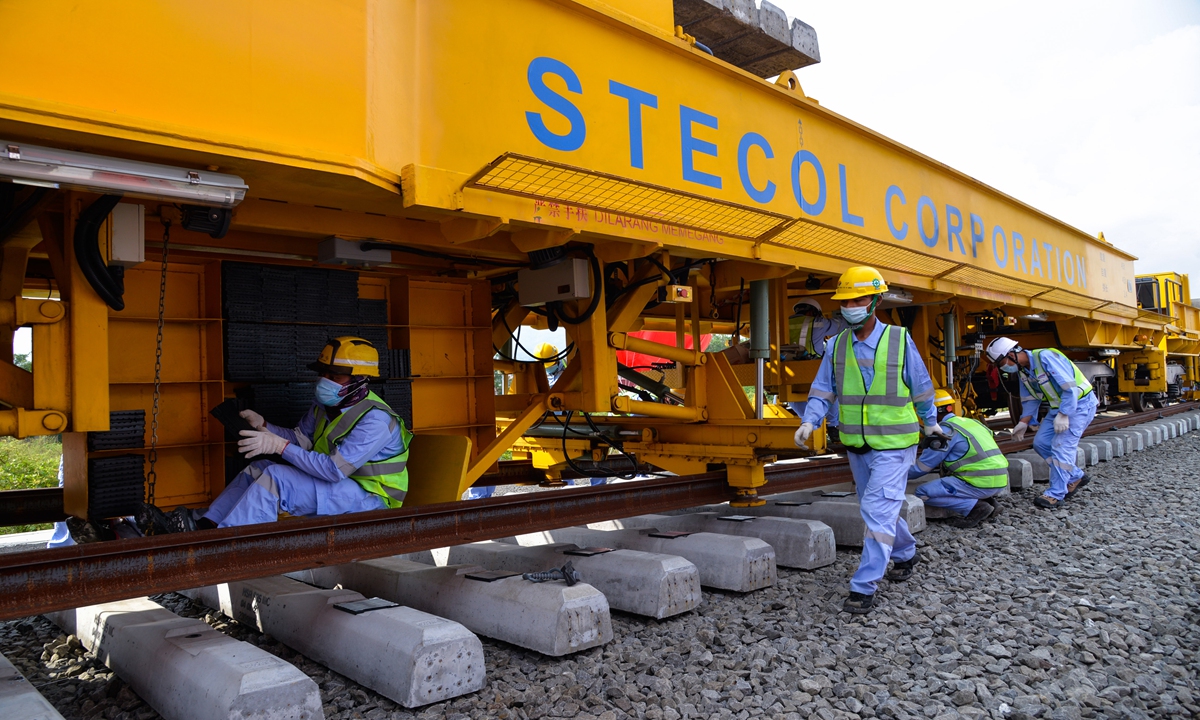
People work at the track-laying construction site of Jakarta-Bandung High Speed Rail in Bandung, Indonesia, on April 20, 2022. Photo: Xinhua
Despite the pandemic in an increasingly complex world, China and the Association of Southeast Asian Nations (ASEAN) have seen a strengthened economic and trade ties this year ranging from initiatives under the Regional Comprehensive Economic Partnership to the deeply integrated industrial chains, amid joint efforts that have injected strong impetus into regional development.
From the increasing number of new railway projects to industrial parks and other infrastructure initiatives linked with people's livelihood that become a reality, there is abundant evidence that China-ASEAN cooperation has entered a new fast track, despite the US' relentless attempts to disrupt ties by offering a so-called substitute of the Belt and Road Initiative (BRI).
Fruitful cooperationWith the first 500-meter rail laid for the Jakarta-Bandung High Speed Railway (HSR) on April 20, the latest regional signature project marking pragmatic cooperation between China and Indonesia has entered new construction phase.
The China Railway Fourth Bureau, the developer of the rail link, said in a statement sent to the Global Times on Wednesday that as of April 30, the total length of the rail section under the company's administration reached 31.17 kilometers in length, and the completion rate of the main project already reached 82 percent.
In addition, 95 percent of the superstructure and beam erection work for four extra-large bridges under the rail project had been completed, and all beam erection work is planned to be completed by May 25.
The main line of the Jakarta-Bandung HSR in Indonesia is 142.3 kilometers long, of which 83.5 kilometers are ballastless tracks using an adaptation of advanced technology independently developed by Chinese companies, the first time that this independent intellectual property technology being adopted in an overseas project.
Once the project is completed, the travel time from Jakarta to Bandung will be shortened from the current three hours to only 40 minutes, a significant boost for travelling while promoting regional economic development, according to media reports.
"China is willing to work with Indonesia to jointly achieve the completion and opening of the Jakarta-Bandung HSR as scheduled," Chinese State Councilor and Foreign Minister Wang Yi said when holding a video meeting with Indonesia's Coordinator for Cooperation with China and Coordinating Minister Luhut Binsar Pandjaitan on May 6.
The rail project is only one of many examples of how the projects using China's investment and technology benefit local people and broader economic development. In parallel with the railway construction, another key transportation project with Chinese company's support is also underway as scheduled - the four-lane Korea-Myanmar Friendship Bridge that provides a route from downtown Yangon to Dala in Myanmar.
China Civil Engineering Construction Corporation (CCECC), the developer behind the project, told the Global Times on Wednesday that the main section of the cable-stayed bridge is currently under construction, with the underwater structures due to be completed by late July.

Design sketch of the Chinese company-built Korea-Myanmar Friendship Bridge Photo: Courtesy of China Civil Engineering Construction Corporation
At present, there is no bridge connection between these two areas, and local people who travel back and forth between the two places have to rely on ferries, which is dangerous and inconvenient.
But this issue will be resolved after the completion of the bridge project, which will not only greatly improve the living standards for local residents but also form a new special economic zone on the Dala side to promote economic development of Myanmar, according to the company.
As Myanmar borders Southwest China's Yunnan Province, where CCECC has set up a base, the Yunnan base and Myanmar can therefore be effectively linked, which enables materials, personnel and equipment to be easily mobilized to increase the construction efficiency and greatly reduce the costs.
The company has established a good reputation in the ASEAN, especially when the epidemic continued to surge. The company ramped up epidemic prevention measures and medical protection, such as closed management, to ensure the normal production.
For example, the company has still managed to continue the construction of the current Dala Bridge project amid epidemic outbreak and the changing situation in Myanmar, which enhanced the company's credibility and influence. Many countries in the ASEAN region have relatively good economic conditions and higher engineering and technical standards than many other countries, according to the company.

Design sketch of the Coronation Square in Johor Bahru, Malaysia. China Civil Engineering Construction Corporation is the constructor of Coronation Square Tower 5 office building. Photo: Courtesy of China Civil Engineering Construction Corporation
However, these local companies suffer from limited access to capital and low efficiency, CCECC said.
Comparatively, CCECC has its advantages in terms of business scale, capital, and technology, which enables the company to focus more on large-scale projects with large amount of engineering and high technical difficulties.
Cooperation between China and ASEAN has always maintained a positive momentum and has continued to expand. Even in 2021, when the pandemic was widespread in many parts of the world, China's non-financial direct investment in ASEAN still amounted to $13.67 billion.
UnbreakableWhile the substantive cooperation is progressing between China and ASEAN members, the US' attempts to disrupt the regional development by containing China's participation have never stopped, especially since the US-led G7 rolled out an initiative known as the Build Back Better World (B3W), a political stunt to challenge the BRI.
The US-ASEAN Summit that is taking place in Washington DC on Thursday and Friday is widely seen as the latest attempt of the US to counter China, with the B3W a possible subject to be discussed.
But industry insiders and experts believe that these attempts will fail as the US infrastructure plan is not only financially infeasible but also non-competitive compared with the BRI, given China's technology and construction capabilities when it comes to infrastructure-related projects.
Wang Yongzhong, head of the Institute of World Economics and Politics under the Chinese Academy of Social Sciences, told the Global Times on Thursday that while the talks about the infrastructure will be an important part of the meeting, its impact to the projects with the participation of Chinese companies will be limited.
The B3W initiative is committed to four areas of focus, "climate, health and health security, digital technology, and gender equity and equality," according to a White House statement in June 2021, which Wang said is quite different from China's focus on roads, railways and bridges, which play an important role in the development of ASEAN and produce direct outcomes for the improvement of standard of living and economic growth.
The B3W relies on mobilizing private sector capital and investments from development finance institutions from the G7 and its partners.
But this could mean that the investors seek short-term returns and are unlikely to take risks, experts said.
"Infrastructure has a great demand for funds, and it is difficult for the US and some of its allies to raise such a large amount of funds in a short period of time, while the infrastructure construction cycle in Southeast Asia is long," Wang said.
In contrast, China invests more through long-term development finance, and the funds will be more stable and long-term, Wang said.






